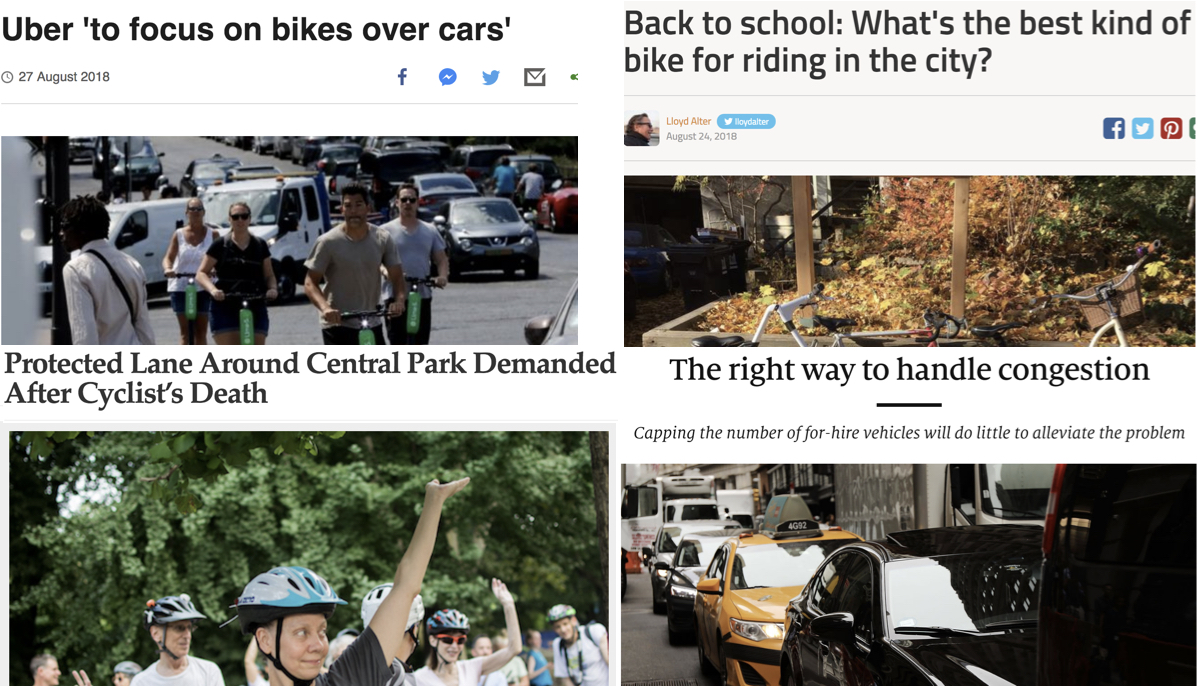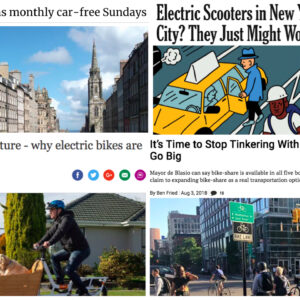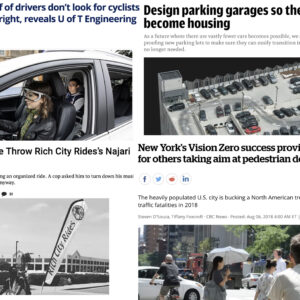Welcome to the week.
Before we get started, a special shout-out from our sponsor Cycle Oregon is warranted. Their new Gravel ride is coming October 5th-7th and it’s sure to be a fantastic weekend of fully-supported unpaved adventures on some of the best backroads in the region. I checked out one of the routes recently and can’t wait to share a recap!
And with that, here are the most noteworthy things we came across on the Internet in the past seven days…
Scooter advocacy: The Willamette Week devoted an entire issue to Portland’s scooter revolution that included an article on how many bicycling and transportation reform advocates consider them an ally in shifting the status quo on our streets.
Real speed enforcement: While local media and PBOT wring their hands about scooter speeds, a police chief in the UK is doing something worthwhile: He wants a £100 fine levied against anyone who drives one mile over the speed limit.
“Bike lanes” no more?: The rise of scooters spurred transit consultant Jarrett Walker and Portland transportation activist Sarah Iannarone to consider renaming “bike lanes” to be more inclusive and descriptive.
Protection imperative: NYC activists are calling for a ring of protected lanes around Central Park after a woman was run over and killed by a truck driver after she tried to avoid a driver who was parked in the bike lane.
We told you so: Uber’s CEO has finally seen the light when it comes to personal transportation; telling a major international newspaper that, “It is very inefficient for a one-tonne hulk of metal to take one person 10 blocks.”
Why we run: In one study, nearly half of the people convicted of hit-and-runs said they did it out of sheer panic.
Bikes for the city: Venerable Treehugger blog author Lloyd Alter shared a useful breakdown of bicycle types and how each one fares as a “city bike”.
Advertisement
E-demand: After doing something similar with scooters downtown a few weeks ago I can relate to this story in CityLab from a guy who searched for an e-assist Citibike. People love these things! We need to commit more resources to electric bike and scooter systems ASAP.
Tour winner, helmet loser: Tour de France champion Geraint Thomas accidentally stepped into the infamous helmet debate when he told an interviewer they should be mandatory for everyone.
Congestion pricing rules: Transportation policymakers and elected officials would be wise to heed this advice from The Economist on how to price driving trips.
Land-use and bike theft: An interesting study (from 2016) looked how land-use and environmental factors influences the rate of bike theft in London.
Don’t say it never happens: A woman riding her bicycle in Aspen ran into a parked car and was charged with BUI. Police say she was texting, had a half-empty beer can in her bottle cage, and failed a sobriety test.
— Jonathan Maus: (503) 706-8804, @jonathan_maus on Twitter and jonathan@bikeportland.org
Never miss a story. Sign-up for the daily BP Headlines email.
BikePortland needs your support.







Thanks for reading.
BikePortland has served this community with independent community journalism since 2005. We rely on subscriptions from readers like you to survive. Your financial support is vital in keeping this valuable resource alive and well.
Please subscribe today to strengthen and expand our work.
One of the things that surprised me in the Willamette Week Article was in the section about each of the three companies doing trials in Portland. One of them ( Lime I think) stated that the average life span of one of their e-scooters was 4 months. If this is really the case ( and I feel this needs further investigation) these things are not the environmental boon some profess them to be. The amount of waste products and lost resources that would result from hundreds of thousands ( nation wide) of these plying the streets on 4 month birth-to-death cycles would be horrific.
I’m pleased that product life is getting some attention in this context.
“What is dying in that lifespan though? Is is the battery or other components of the scooter?”
My hunch is that
(1) these scooters are simply not built to last, which leads to
(2) the risk of spiking maintenance costs beyond some fairly short period going up.
But something else I’ve mentioned before could also be playing a role –
(3) the very premise of these things is their newness; just look at how quickly we here in Portland have apparently tired of the considerably more expensive orange bikes. You can be sure that someone out there sending purchase orders to Chinese factories is paying close attention, and has determined to make these things obsolete in 18-24 months, at which point they will have drones or personal helicopters or something else ready to market as the new environmental solution to a problem we hadn’t yet identified.
Well that is certainly one of the more obvious specific complaints, but I’ve read more general ones as well.
https://bikeportland.org/2018/08/14/opinion-scootering-is-very-popular-and-hasnt-destroyed-portland-287492#comment-6931152
When I’ve talked with our local LimeBike reps, my understanding is that the units are so cheap, and new upgraded ones coming in so fast, that it is easier for them to replace broken units than it is to repair them. They agree it is wasteful and environmentally dubious, to say the least, but it does save them a lot of money on personnel costs. It’s a business after all, just like Ford cars or Brampton Cycles.
“It’s a business after all, just like …”
Careful.
Folks here are pretty keen to claim all kinds of virtuousity in relation to these devices.
Still waiting for some data….
This. The last few months it’s been nearly impossible to check out a BikeTown bike. I don’t think people are tired of them (except in terms of the recent difficulties).
I suspect BUI happens much more frequently than people think.
And yet, it’s a meaningless blip when compared to the threat of drunk driving. I wonder how many parked cars were hit by drunk drivers the same day?
We arrest drunk drivers because they are drunk, which is the crime. Anything they do afterwards is a different crime.
Incredibly ignorant statement made to attempt to back up a false equivalency.
Drunk driving is a crime because it causes harm to others. You can make the argument that drunk cycling does that, but you’d be grasping at straws.
There’s a Subaru in Colorado feeling dismissed by your comment.
Has it tried therapy? I have heard there are experts on diagnostics and car philosophy out there, ready and willing to help your car find itself again.
In fact, I wonder how many people bike because they’ve lost their driver’s licenses due to drunk driving? Or decide to bike home from drinking instead of driving? I’m not condoning drunk biking, but at least it’s less potentially harmful to others than drunk driving.
And in this case, it could have been the texting that caused the crash, although drinking may have led to the decision to text.
A 200 pound cyclist-plus-bike riding drunk is wrong, but is neither morally nor mortally equivalent to a drunk driver operating a 4000 pound car.
I think it happens constantly.
The way Thomas answered that question reveals how little he has actually considered the issue. He’s not a politician. He’s not running a helmet advocacy group. He’s a pro rider who was asked a leading question.
But, to be fair to Thomas, his answer can also be understood in other ways as the interview apparently didn’t develop the subject (I haven’t seen the full interview or read the transcript). He could be answering the question as it pertains to him in racing. There was a time when helmets were not standardized and their use was not enforced. I vaguely remember a TdF which went into Belgium and the riders had to don helmets at the border because France had not yet required riders to do so.
It’s also possible that as a younger rider, he’s of the generation where parents rigorously instructed their offspring to wear helmets, especially before the age of 16, and the habit simply stuck.
I would be fine with requiring the companies that make and supply e-scooters to govern them to the speed limit if and only if we hold motor vehicle manufacturers to the same standard. It is technically feasible, and not even that difficult, to have cars govern themselves to the speed limit on the street they are on.
Imagine how many lives could be saved by this (probably over 20,000 per year, since excessive speed is a factor in most fatal crashes). If we don’t trust people operating a thirty-pound e-scooter to be reasonably safe, why do we trust people to do so with 5000 pound motor vehicles, especially when we have so much evidence that they don’t operate them at safe speeds?
Our local transportation director, an otherwise conservative ‘good ol boy’, has publicly advocated for car and truck “speed governors” to be installed in all new vehicles, with speeds governed by electronic skus stuck to the back of speed limit signs on every street. He says the technology is already out there and is being tested in Australia.
My god, those hit and run descriptions!! Beyond horrifying. Especially the woman who drove home with the guy embedded in her windshield and kept going back to her garage periodically asking him if he was ok until he bled to death three days later, at which point, she enlisted a friend to help drag him to the park and leave him there. Frustratingly, the reporter notes that hit and run accidents are on the rise and gives people’s reasons for fleeiing but offers no stats from past years for comparison to shed light on why this problem is getting worse. Did I miss something?
They are on the rise for the same reasons people are worse drivers now, Greed,self centered ness, lack of foresight,etc. It is self selecting because in this day and age anyone who is emphathetic, logical, and cares about the future for themselves and others is no longer driving or driving very little.
Your own private bicycle can last 100 years.
Yes, but in that case the bicycle arguably is tolerating you as its temporary client, like a Stradivarius. Ownership is inverted.
Assuming your storage environment has no acid in the air (rust) and you never ride the bike, it may last your lifetime. I work with a local nonprofit that processes over 500 used bikes annually, fixing and giving away about half for youth, refugees, and immigrants, the rest go to the dump. Contrary to what you might think, even aluminum can “rust” or corrode, usually from too much sweat from riders dripping on the downtube and not being promptly wiped off.
A heavily-ridden bike, even a $5,000 custom one, will eventually get metal fatigue on the frame, usually first on the dropouts, the chainstay, and the seatstay bridge, but eventually the bottom bracket will give out and the bike will no longer be salvageable. And of course the parts will give out long before then. Chains stretch, the middle chainring starts to resemble a throwing star, tires wear down, parts become out of date, cables wear out, and even the headset can gum up.
But then again, what you might call your best 100-year bike, your children and grand children will refer to as Jim Lee’s POS, and after you die of natural causes, they will likely give it to a group like ours for free as a tax-deductible donation and we’ll give it to a needy user or sell it as scrap metal. Or a chop-shop will mix and match the parts. Go figure.
My oldest trike has 24,000 miles on the frame. 4k in the several years before I owned it, and 20k in the last 5 from me.
The wheels I originally had built for it only lasted 5k miles – to be fair, they were A23 rims and simply weren’t up to a 195lb guy with an FTP of 325w throwing them through curves at speeds that often had the inside wheel lift 😉
All weather commuting wears the chain, cassette and middle chainring out in about 5k miles.
When I used to go over the west hills on my commute, BB7 brake pads lasted 2500miles, now about the same as the chain et. al. The other rings last twice as long.
Mega Exo BB replaced once, headset bearings replaced once, front wheel bearings replaced twice. The Cliffhanger rims all round handle the rough roads and “enthusiastic” riding style well and are going strong.
Cables and housings several times, Arkel frame bags replaced once (that all weather commuting – the zippers rusted and broke). I think I replaced the BB7’s (rotors & calipers) just once. I just replaced the front 20mm axles. I’ve replaced the rear DR 3 times. Pedals twice.
On the other hand. Everytime I ride it saves $5 on transit costs for that day. 3 days of commuting a week translates into $780/year (closer to $700 with occasional things keeping me from riding) – so even with the yearly maintenance budget I come out ahead.
But, yes, even riding does have it’s natural resource impact.
“100 year bikes”
In my case, please divide by 21.
I’ve worn out 7 metal bike frames in the past three decades or so merely via use. In some cases these metal frames lasted only a few years before they cracked at the bottom bracket.
Portland seems much less committed to low impact living in the last few years. I’ve been trying to figure out where this shift is coming from.
Lower income people are being economically displaced from inner Portland.
Who the heck is seriously advocating that bike lanes be shared with runners, skateboards, e-scooters, and dogs?
It must be the runners-skateboarders-e-scooter-and-dog lobby. Because I don’t know any cyclist who wants to be dodging dogs, skateboards, runners, or scooters in the bike lane.
Not in the real world anyway. Maybe in the ScooterPortland.org bubble the urban theorists think it would be a good thing.
Those darn bicycles! Car lanes are for cars! Get them off the road! They don’t belong here, they are toys that need to be ridden in parks!
Ahh, the irony.
Well, there is also some irony in the fact that “cars” usually have multiple, wide lanes to use and are all capable of going at least 10 over the speed limit. It doesn’t matter whether you mix motorcycles, trucks, SUVs, sedans, Corvettes, whatever motorized vehicles you want to mix—all those vehicles are accommodated to the extent they need. A curb-hugging bicyclist might take up 1/3 of the width of a normal “car” lane, and unless they are centrally- or left-positioned, most drivers will feel no compunction about passing a bicyclist who is “hogging” “their” lane. In contrast, attempting to mix foot, human-powered, and electric-powered traffic all in a single 5′ – 6′ lane—if one even exists—can create a different set of problems.
I had a hard time just getting past that “lane chart” using kilometers per hour instead of miles. What’s the point of that?
In Portland, scooters, skateboards and inline skates have legally had the same rights to the road and to bike facilities as actual bikes, since (if memory serves) the late 1990s. Get used to it.
In eastern Washington throughout the 1990s, people who had lost their drivers license to repeated DUIIs were the only ones you saw out on the roads at night on bicycles. I do too wonder at the numbers behind this reality and given the threat that a slow moving bike presents versus a partially-at-best-controlled 2,000+lbs. motor vehicle, we can agree that it is the far lesser of two evils however figurative one of the two might be.
Land Use and Bike Theft: Super dense academic article, not for people with short attention spans.
Implications
The major policy implication of this research is that law enforcers and policymakers can focus on certain aspects of the physical environment to strategically prevent bicycle theft, given the well-known difficulty of solving this type of crime after it has occurred. With respect to the facilities directly associated with mobility, or to the linkage of different mobility systems, both train stations and bicycle parking stands have been shown to pose high risk for bicycle theft. Such places need to be evaluated, keeping the seasonal variation and the crime problem in surrounding areas in mind. Other amenities unrelated to mobility but nevertheless availing interaction and opportunities for bicycle theft also require security prioritization, such as universities, vacant houses and street-lining trees.
When considering where and how to prevent bicycle theft, the exposure to risk factors within the physical environment might have profound implications for developing strategic prevention mechanisms within small areas. These environmental factors might be more pertinent than the sociodemographic composition, which is usually quantified over larger and arbitrarily defined areas.
Correspondingly, ethnographic evidence has revealed that even in the census blocks with crime-aggravating socioeconomic influences, crime is not ubiquitous. Such an observation challenges us to look beyond areas that are contextually meaningful to identify factors that could influence crime, factors other than those conventionally measured along with area-based socioeconomic status.
That was a nice summary. Thank you, David.
I found it interesting as well, but didn’t have the chutzpah to attempt a summary.
Very nice days at SunRiver here, zipping along the beautifully paved paths between sessions of replacing nails in the deck with drive-screws.
Lovely trip to Benham Falls on Saturday. Cruised the River Loop on Monday: subtle morning sunlight through broken clouds; water, meadow, forest alive with color. Polite police patrolling on MTB.
Trusty steed was custom frame fixie with 32 mm slicks on 559 mm half-spoked crow’s-foot wheels, 42/16 gear with 1/8 chain. Modest track-skills very useful. That bike is a tiger on the twisty paths with short steep ups and downs. Must take care with dogs, kids, moms with strollers. Rode through the new tunnel at Circle 4: two smooth lanes straight through; all the infamous “walk-your-bike” culverts are to be replaced.
Two sessions in the new hot tub Monday night. Full moon. There is a head-rest in one corner so one can lean back to observe the stars.
Cheers!
I don’t have the chutzpah either. I took the summary directly from the article.